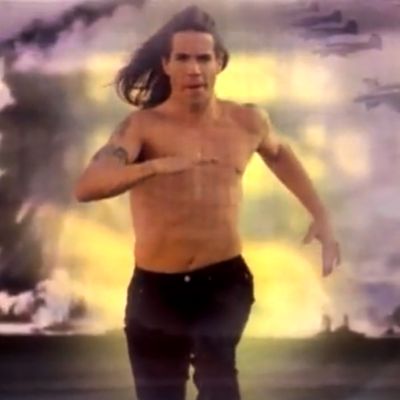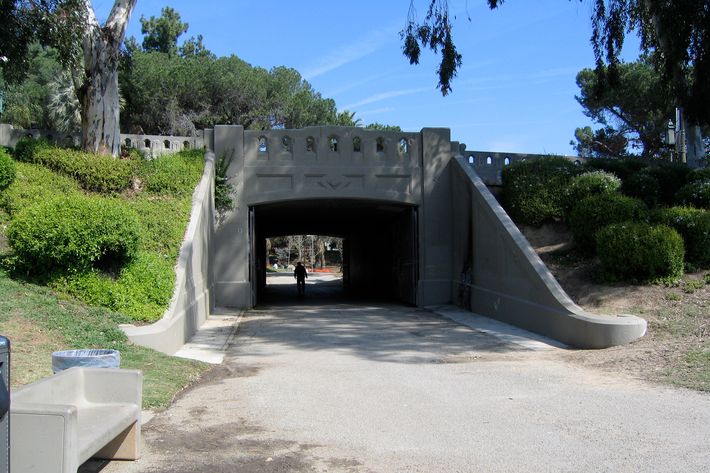
Randy Newman may proclaim, ÔÇ£I Love L.A.,ÔÇØ but Los Angeles is deeper, richer, and more vibrant than that shouty stream of Chamber of Commerce clich├®s. For an Angeleno like me, ÔÇ£Under the BridgeÔÇØ by the Red Hot Chili Peppers comes closer to capturing the cityÔÇÖs true vibe.
It starts out sunny: ÔÇ£I drive on her streets ÔÇÿcause sheÔÇÖs my companion / I walk through her hills ÔÇÿcause she knows who I am / She sees my good deeds and she kisses me windy / And I never worry ÔǪ ÔÇ£
And then takes a dark  very L.A.  turn:   Now that is a lie.
The 1992 single, off the album Blood Sugar Sex Magik, was a turning point for the Chili Peppers. Their first mainstream hit, the song went platinum, peaking at No. 2 on the Billboard ÔÇ£Hot 100.ÔÇØ Coupled with a video directed by Gus Van Sant, it pushed the formerly underground hard funk band into the public eye and made the Chili Peppers international rock stars. That this worldwide acclaim sprang from a fairly dark place only gives the song a pathos (and a kind of dangerous gravity) absent in most pop music. In his memoir Scar Tissue, Anthony Kiedis talks about how the song came out of a sense of loss and isolation. This feeling reminded him of his drug addiction and the day he hit rock bottom ÔÇ£downtown with fucking gangsters shooting speedballs under a bridge.ÔÇØ
But what bridge is Kiedis singing about? In a 1992 Rolling Stone interview with David Fricke, the singer refuses to divulge the location. Its downtown  but its unimportant. I dont want people looking for it, he said, perhaps uneager to have a new pop-music landmark emerge from one of his lifes lowest moments. When contacted recently, the bands management refused to comment about the possible location of the bridge. We decided to look for it regardless.
In his memoir, Kiedis recounts how he and his friend Kim Jones ÔÇ£owed too much money to the drug dealers around Hollywood, so we started walking from her house, which was not far from downtown L.A., to known drug neighborhoods, mainly Sixth and Union.ÔÇØ (That street name struck a chord: In the song ÔÇ£Down on Union StreetÔÇØ by L.A. post-punk band Thelonious Monster, singer Bob Forrest sings, ÔÇ£ThatÔÇÖs where my baby gets her dope.ÔÇØ Addict Forrest would later go on to become a Celebrity Rehab addiction counselor.)
I broke out an old Thomas Brothers Guide ÔÇö a massive chunk of map that is a thousand pages thick ÔÇö and looked for obvious routes from downtown to Sixth and Union. I called the California Department of Transportation and learned that any span ÔÇ£over twenty feet longÔÇØ is considered a bridge and there are thousands of these structures in Los Angeles County. To try to narrow that down, I looked at BridgeHunter.com, a database for all bridges in the United States, and found over 200 in the greater Los Angeles area. But only three of those could potentially be the one he sings about, and each is problematic. For starters, theyÔÇÖre not that close to Sixth and Union. ┬á┬á
The First Street bridge is a steel stringer structure that spans Figueroa Street. It is open to a busy street and offers the narrowest of walkways underneath. IÔÇÖm not sure you could even sit down there without getting run over.┬á The bridge at Temple and Figueroa, a 44-foot span built in 1940, has a similar problem. ThereÔÇÖs just no ÔÇ£underÔÇØ under there. In fact, the only bridge that looked even remotely likely ÔÇö where Beverly Boulevard crosses over Glendale Boulevard ÔÇö is, like the others, too exposed to traffic for late-night speedball fun.
So I asked a writer friend, a former junkie, about where in that area they would get their dope, circa the late eighties. He said, ÔÇ£I bought in some vacant lot off of Seventh and, maybe, Hoover. The details are a bit fuzzy, as those werenÔÇÖt my regular spots to score.ÔÇØ I looked at my map. Between Sixth and Union and Seventh and Hoover lay MacArthur Park, an urban oasis made famous by the Jimmy Webb song about a neglectful baker, first recorded by Richard Harris in 1968.
Kiedis said that he went ÔÇ£under the bridgeÔÇØ in 1988. By that point, the park had become notoriously drug infested and dangerous. A Los Angeles Times article from April ÔÇÖ89 headlined ÔÇ£Drug Users Overrun MacArthur ParkÔÇØ cited rampant and open drug use in the park, and a subsequent police crackdown that year yielded 859 drug arrests in the first quarter alone. It was well known throughout the city as a place ÔÇö┬álike many Reagan-era urban parks ÔÇö where one could reliably score drugs. But there are no bridges close enough to count as a place where you might draw some blood, forget your love, or give your life away.
After staring at the map for hours, trying to plot every conceivable approach, I became convinced Kiedis made it up. I mean, why not? Does it matter if itÔÇÖs a real bridge? Maybe itÔÇÖs a metaphor. Or maybe he was afraid to admit he hit his low point in MacArthur Park because people would forever associate his existential crisis and subsequent sobriety with an oft-mocked song about a soggy cake.
To be certain, I walked down Sixth, past Union Street, and made my way into the park.
It is a pleasant space, with palm trees and benches, grassy areas for picnics, a small lake, and paths for strolling. ItÔÇÖs hard to imagine that when the lake was drained in 1978, workers discovered hundreds of discarded handguns and knives rusting in the mud. I walked toward the lake and discovered a small pedestrian tunnel underneath Wilshire Boulevard, which bisects the park into north and south. ItÔÇÖs not much of a span ÔÇöalthough Caltrans would define it as a bridge ÔÇö and instead of looking like some dark and forbidding portal to hell, it was painted with graffiti in the form of a friendly octopus. Inside, it looked like a school art project had been painted over decades of tagging, layers of violent history under a family friendly mural. It might be clean and safe and have a happy octopus, but not that long ago it was the stomping ground of gangbangers and dope slingers.┬á

It must be the bridge in the song. It links Sixth and Union ÔÇö the intersection Kiedis claims he was walking toward ÔÇö with the drug dealers at Seventh and Hoover. And, unlike the other bridges, it provides a discreet location for private time with personal demons.
Mark Haskell Smith is the author of Heart of Dankness: Underground Botanists, Outlaw Farmers, and the Race for the Cannabis Cup (Broadway) and four novels.
This is the first in VultureÔÇÖs Pop Culture Mysteries series, which will occasionally try to investigate long wondered about questions in music, movies, TV, and books. WeÔÇÖre on the lookout for more mysteries, so please let us know of any youÔÇÖd like to see solved over at our Twitter handle, @vulture.

